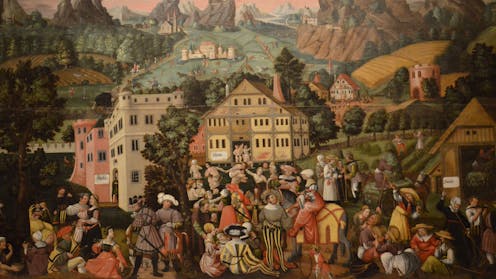Six tips from the middle ages on how to beat the summer heat
Summers in the 1500s were hot. Wikimedia
England has entered its fourth heatwave of 2025. Historical comparisons for our current weather situation have seemed to beach at 1976.
Seared into the memory of many Britons over 55, that was the year when temperatures stuck at 30 degrees and there was no rain for nearly 50 days in a row. As a result, the UK government was forced to ration water. But Britain’s longest dry spell of the 20th century was not the worst for the wider continent.
For heat intensity and human cost across Europe we need to return to 2003. Back further, the heat and drought of 1911 easily eclipsed 1976 for European impact and before that 1757. And, above all, 1540, when there was no rainfall for almost the entire year. German chroniclers recorded that it was possible to walk across the Rhine.
Reaching further into the medieval past, the North Atlantic region passed through a climate anomaly between the 10th and 13th centuries. Research temperatures rose to around one degree celsius above the level that was typical at the turn of the 21st century.
Medieval Europeans became accustomed to hot, dry seasons – and they knew how to endure them.
Sadly, their experience cannot set us on a different course but it may have something to teach us about how to survive. Researchers are beginning to recognise that there are lessons for our own sustainability in the middle ages’ management of the environment, agriculture and food production. The same may be true in how they lived and worked under the sun.
Here are six tips from the middle ages to beat the heat:
1. Work flexibly
In June, July and August, start work at the first light of dawn, advised the 14th-century shepherd, Jehan de Brie, author of Le Bon Berger (The Good Shepherd).
Work would begin and end earlier to avoid the worst heat of the day.
Wikimedia
In fact, all three medieval estates – those who worked, prayed and fought – compressed their tasks to the cooler morning hours in the long summer days. Clergy adapted their services to fit a shorter night and longer day and after Corpus Christi (June) their worship year wound down. Knighthood curbed its taste for tournaments. They would never lift a lance in August.
2. Wear the right hat
Although hardly a habit unique to the middle ages, it is only in the past half-century or so that the hat has lost its status as a staple, everyday item.
Hats were worn daily for practical as well as social reasons in European society.
Medieval images, manuscript illuminations, murals and panel paintings, gesture at the endless variety of shaped hats, soft caps and hoods they reached for as a matter of course. For high summer, the half-metre brim of a hat like the Swedish Lappvattnett hat may have been the norm.
3. Eat to lower body temperature
In the unrefrigerated world of the middle ages, food could still be cool. Salad leaves (known then as salat) were preferred because they were palatable and digestable in the heat.
Fish and meat dishes were cooled down for the season by being doused with verjuice (pressed, unripe grapes), vinegar and perhaps even pomegranate juice.
4. Try wild swimming
Swimming was an increasingly common, communal recreation in later medieval Europe. When monasteries allowed their inmates periods of downtime, besides blood-letting, they encouraged river and sea swimming for health, hygiene and general fitness.
A woodcut fro Everard Digby’s book on swimming.
In late medieval European cities crowded with tens of thousands, the breadth and depth of the Danube, Rhine, Seine and Tiber were an essential lifeline. The medieval theologian Everard Digby’s manual on the Art of Swimming, first published in 1587, described what may have long been a common sight – leaping and diving through the water “just like the summer’s roach”.
5. Use aftersun
Look after those burns. The monks of Citeaux Abbey were chronicled gathering herbs and roots in summer to salve their “perished skin”.
A 10th-century book of remedies, Bald’s Leechbook , recommended stalks of ivy sauteed in butter to apply to burns. Later, the recommendation was rosewater distilled from the flower’s petals.
Today we would say a bottle of aftersun or aloe gel will do.
6. Flee
When Emperor Charles V (king of Sicily and Naples from 1516 to 1554) found himself in a sweltering Rome with his young children, who were struggling in the rising temperatures, he made the household leave the city. High society generally left city palazzos to go up country and into shadier climes.
The author Giovanni Boccaccio recalled in his Decameron how the “dames of the city fly off” in summer to their country houses. King Richard II
(1377 until 1399) of England built a summer house at Sheen Palace (now Richmond palace) on the banks of the Thames to escape the close climate of the capital.
Even round-the-clock monastic institutions sometimes broke up and decamped to outlying country priories. Of course, it was rarely an option for those beneath them on the social scale.
Looking for something good? Cut through the noise with a carefully curated selection of the latest releases, live events and exhibitions, straight to your inbox every fortnight, on Fridays. Sign up here.
James Clark does not work for, consult, own shares in or receive funding from any company or organisation that would benefit from this article, and has disclosed no relevant affiliations beyond their academic appointment.




